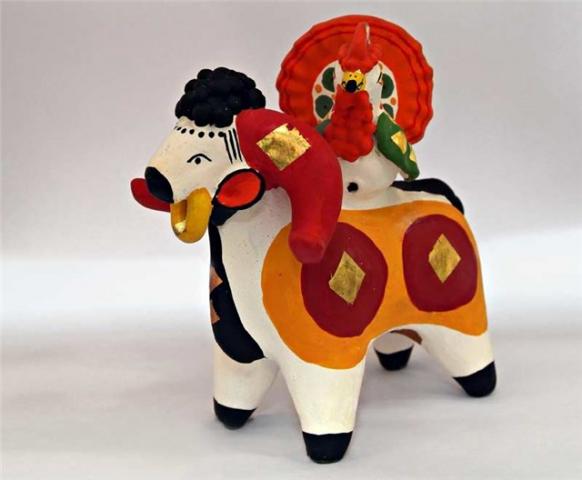The Russian Folk Toy. Part 1. Clay Dolls from Vyatka, Moscow, 1929
Today we travel back to Russia, its fantastic artists and popular traditions.
I discovered Denshin's work during my Soviet-related virtual explorations, and everything
about it immediately attracted me: the subject, the history, the illustrations, and especially
the author's dedication to his passion. Various web searches resulted in these images and
informations, mostly gathered from craft and antique book sellers' websites. Enjoy!
the author's dedication to his passion. Various web searches resulted in these images and
informations, mostly gathered from craft and antique book sellers' websites. Enjoy!
Aleksei Ivanovich Denshin (1893-1948) was a painter, graphic artist, illustrator and author.
He was also part of a group of Russian artists who in the late 1800s began to appreciate and
study provincial folk toys as a traditional art form. Other serious collectors were
the objects of Denshin's fascination were Dymkovo clay toys from the Vyatka region.
Dymkovo toys, also known as Vyatka or Kirov toys, are moulded painted clay figures traditionally
made by women in the form of birds, horses, horseriders, ladies and other people and animals.
This ancient Russian folk art originates from magic ritual images and agricultural calendar holidays.
During spring festivities, clay penny whistles were crafted and then placed on window-sills.
In time the little figures lost their magic meaning and turned into children toys. Until the 20th century,
the toy production was timed to the spring fair called свистунья, or whistler, an event believed to
have existed for some 400 years, thus dating the history of Dymkovo toy at least from the 17th century.
In the late 19th century the Dymkovo handicraft was forced out of the market by factory-made
moulded plaster statuettes, but thanks also to Denshin's work it was revived during Soviet times.
In 1933, an artel called Вятская игрушка (The Vyatka Toy) was organized, which would turn into a
workshop of the Artistic Fund of the RSFSR. These days, Dymkovo toys are a popular Russian souvenir
Dymkovo toys are hand molded from a mixture of local red clay and river sand.
After its various parts are fastened together with liquid clay, the toy is dried,
fired in a furnace and whitewashed with chalk diluted in milk. Finally it is painted
in tempera with bright geometric patterns and decorated with gold leaf accents.
In case you are inspired to create your own clay toy,
In 1917, the same year of the the February and October Russian revolutions,
Denshin published Viatskaïa bliniannaïa igrouchka v rissounkakh, the first illustrated catalogue
of clay toys from the Vyatka region.The book features fifty plates hand-colored by the author and
lithographic text printed in sepia from his calligraphy (note the cutout illustration pasted on the cover).
The colored plates were cut and glued to the pages. In his introduction, the author apologizes for the book's
quality and notes that he colored the plates by hand because conditions in Moscow at the time prevented
printing in color. Denshin was able to produce only 300 copies of the volume, which is now part
printing in color. Denshin was able to produce only 300 copies of the volume, which is now part
In 1926, the early hand-colored catalogue served as the basis for a new edition of 200 copies.
Finally, in 1929 The Russian Folk Toy. Part 1. Clay Dolls from Vyatka was published in Moscow,
a larger print run with 16 color lithographs and a cover designed by Sergei Chekhonin.
Despite the notice on the wrapper and title page, a second volume was never produced.











This is all so wonderful! Thank you Laura for such a variety of inspiring posts. I always find something new and interesting over here.
ReplyDeleteThose clay toys are beautiful!
The clay figures are indeed beautiful, but I love the drawings of them as well!
ReplyDeletesplendide davvero,grazie della segnalazione!
ReplyDeleteThese one proves that in clay toys, you could create anything you want. Those figures are very wonderful. Very creative!
ReplyDeletehi i like it.....!
ReplyDeleteI remember how in children garden we was taught to create dymkovskaya igrushka!
ReplyDeleteI fill prouder after reading your post. It is so pleasant to read about culture of my country from foreigner! Thank you!
Thanks for your comments, so glad you enjoy this!
ReplyDeleteLisichka, I am very glad for you, you should be proud of your country's wonderful traditions!
Dear Laura, your site has just saved me from making a silly research mistake AND you have confirmed a hunch that I had: that there was a state-sponsored revival for such items and other folkart, among artists who would have been working in the state publishing house. I wish I knew how to track down that Artistic Fund of the RSFSR (what is that?). Vicki
ReplyDelete